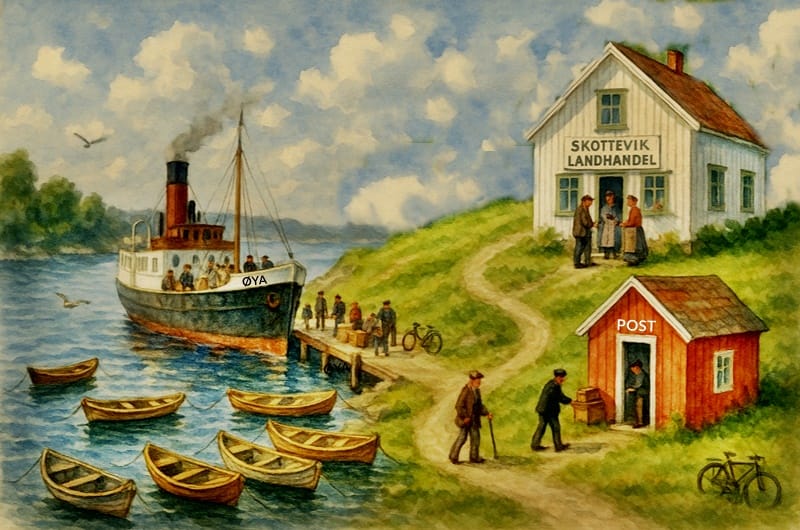Passenger Delivery Day at Skottevik

A Holiday Morning in the Southern Norwegian Archipelago
The day begins with the echoing sound of the coastal steamer’s horn as it rounds the sunlit skerries and glides into the cove. It is leveringsdag — Delivery Day — a small but eagerly awaited occasion in Skottevik, when mail, cargo, and passengers from the wider world arrive all at once.
From her place by the window, one of the two sisters, keepers of the landhandel, spots the first plume of steam rising from the ØYA’s funnel and steps outside. She wipes her hands on her apron and listens — the faint throb of the engine, the distant clatter of gulls, the creaking of moorings — all signs of a day about to come alive.
Down at the dock, the pier already bustles with movement. The ØYA, a sturdy, trusted vessel with a black hull and a proud red funnel, nudges gently against the fenders as she ties up. Her name is painted boldly on the bow: ØYA — the letter slashed through with its diagonal line like a sea mark in the fog.
As the steamer gangway clatters into place, passengers disembark to a cheerful crowd. Deckhands begin unloading: crates of canned milk and flour, two wooden chairs, a new radio wrapped in burlap, a small upright piano in a custom crate — bound, presumably, for someone’s drawing room across the bay.
But long before the steamer arrives, the harbor has begun to fill. Dozens of small, weathered wooden rowing boats are gathered around the pier, each tied with rope or simply nestled alongside the rocks. They’ve come from the many tiny out-islands scattered beyond the skerries — from cabins, boathouses, and sheltered coves where islanders live their quiet, sea-bound lives.
These boats carry people and parcels — mothers with baskets of eggs, older men in oilskin caps, boys with fishing rods balanced across their laps. Some have brought fish to trade, others woven goods or firewood, but most have come for their mail and to collect supplies from the landhandel. In the bottom of one boat, a folded oilcloth hides a half-wheel of cheese; in another, a tabby cat lounges lazily atop a wrapped newspaper, seemingly used to this once-a-week excitement.
Holidaymakers, too, are collected in these boats — couples staying on rented property on these islets for the summer, families with children in yellow lifejackets clutching soft toys. There’s laughter as one boat nearly tips during docking, and applause when an elderly man in a blue pullover rows in standing up, proud of his balance and reputation.
Among the stream of passengers is a young couple: her linen dress fluttering in the wind, his camera swinging from a leather strap. They pause at the edge of the pier, overwhelmed by the beauty of the place. “It’s just like my grandfather described,” she murmurs.
The path from the pier winds up through the low grass, past the red-painted post shack — “POST” painted clearly in white above the door — where a line is already forming. One of the sisters, sharp-eyed and efficient, hands over mail bundles, old parcels, and telegrams. A boy calls out to her: “Did my magazine come?” and she waves him in.
At the top of the path, the Skottevik Landhandel stands in quiet readiness. White-painted and weathered, it watches the harbor like a sentinel. Flower boxes burst with red geraniums beneath the windows. Innside, the sisters greets each arrival: the islanders who know them by name, and the visitors with maps.
The young couple arrives, their cheeks pink from the walk, and buy a loaf of bread, a jar of blueberry jam, a tin of cocoa, and matches for the old woodstove. “Your house’s ready,” one of the sisters tells them, “though you’ll want to open the shutters wide. It’s been sleeping all winter.”
Around the shop, life unfurls in its gentle rhythm. A fisherman buys tobacco and lingers for conversation. Two children run toward the sweet jars, coins warm in their palms. A woman knits silently on the bench, while a dog naps in the shade of the bicycles leaning against the wall.
As the steamer departs once more — her deep whistle echoing across the fjord — the wooden boats begin to disperse. Some row slowly back out to sea, others linger, their owners swapping news, sipping coffee from thermoses, or simply letting the moment stretch. One man has forgotten his oil for the lamp and rows back quickly, calling out good-natured apologies. A girl paddles solo in a tiny painted boat, grinning with pride as her oars splash quietly in the clear water.
In Skottevik, this day is not an event so much as a rhythm — a soft arrival, a shared breath, a link between the scattered islands and the gentle heartbeat of the coast. Here, where time slows with the tide, the world feels intact, cradled between sea and sky. And the little boats, each with its story, return across the shining water — until next week.
A Gentle Philosophy of the South Coast
In the sheltered inlets and quiet islands of Southern Norway, life moves in a rhythm older than roads and schedules. Here, between the sea and the sky, the human heart remembers what it once knew instinctively — that time is not something to conquer, but to live alongside.
On days like Delivery Day in Skottevik, the archipelago seems to breathe as one — each island, each boat, each hand extended in greeting part of a deeper harmony. The landscape does not boast. It offers. The weathered jetties, the creaking sign above the shop door, the sisters who knows your name — these are not grand things, but they are true things. And truth here takes the shape of kindness, of steady presence, of shared routine. There is a warmth, unmistakable, in how people wave from boats, share their catch, or help a child climb from the rowboat to the dock.
Even the sea, which elsewhere can seem vast and unknowable, becomes a thread of connection — the highway of wooden boats, laughter, goods, and letters. The sea here is not a border, but a bridge.
It is in such places that hospitality becomes more than custom — it becomes a worldview. A way of saying: You belong here, if only for a while. And indeed, even strangers are absorbed gently into the pattern. The young couple from the city, the curious children on the pier, the summer guests in borrowed cottages — all are welcome not with ceremony, but with that quiet nod of inclusion that means far more. You matter, here. You are seen.
Perhaps it is the sea air, or the clean northern light, or the long winters that shape such communities. Or perhaps it is simply the wisdom of those who live close to nature — who know the value of sharing warmth while it lasts.
For in the end, the true wealth of the southern archipelago lies not in its painted houses, nor even in the beauty of its coastline, but in the spirit of its people — open-hearted, steady, and kind. A spirit that welcomes the world, one wooden boat at a time.
And as the last oars dip into the gleaming water, the wake slowly fading behind them, one feels — deeply, quietly — that all is well.
